Business Law Assignment: Contract and Negligence Analysis
VerifiedAdded on 2020/01/21
|13
|4359
|80
Report
AI Summary
This report delves into the critical aspects of contract law and negligence within a business context. It begins by outlining the essential elements required for a valid contract, including offer, acceptance, consideration, intention to create legal relations, and capacity. The report then explores various types of contracts, such as unilateral and bilateral, seal (deed) and simple, written and verbal, and face-to-face versus distance selling contracts. It proceeds to analyze different types of contract terms, including expressed terms, conditions, warranties, innominate terms, exclusion clauses, and implied terms, providing relevant case examples for each. The report further examines negligence liability through case studies, including scenarios involving advertisements and faulty products, and discusses the applicability of legal elements, terms, and remedies, referencing the Sales of Goods Act 1979 and the Consumer Rights Act 2015. Overall, the report offers a comprehensive overview of contract and negligence principles and their practical application in business operations.
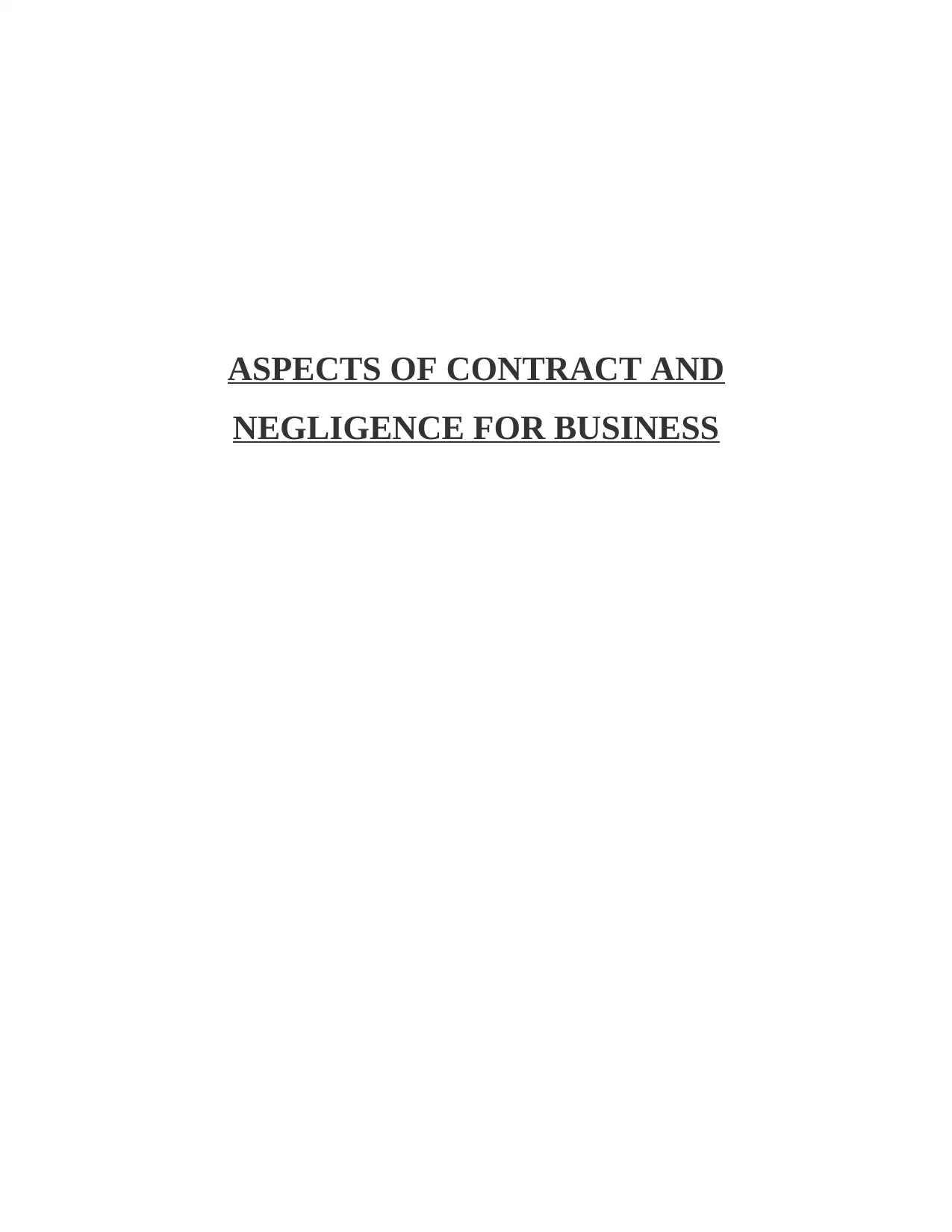
ASPECTS OF CONTRACT AND
NEGLIGENCE FOR BUSINESS
NEGLIGENCE FOR BUSINESS
Paraphrase This Document
Need a fresh take? Get an instant paraphrase of this document with our AI Paraphraser
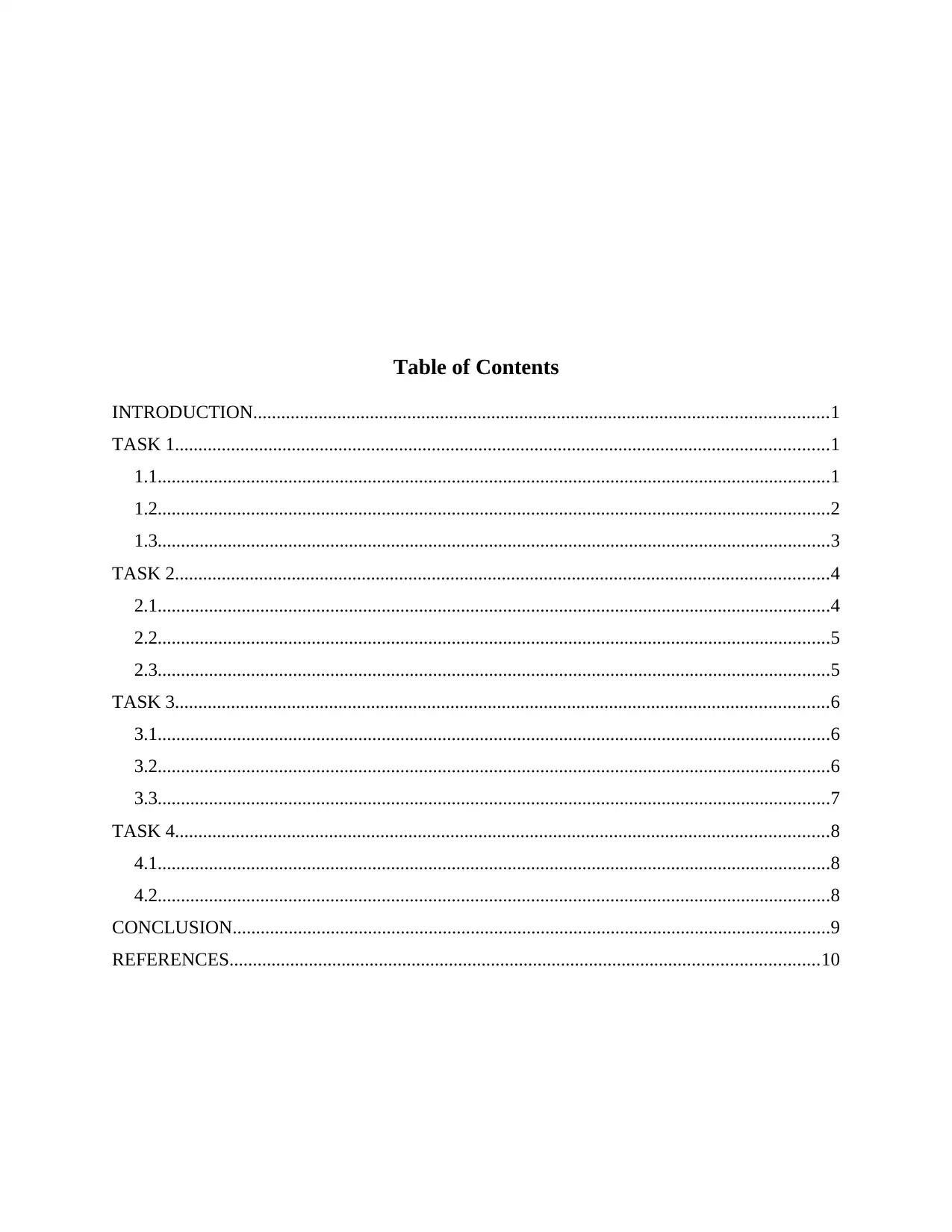
Table of Contents
INTRODUCTION...........................................................................................................................1
TASK 1............................................................................................................................................1
1.1................................................................................................................................................1
1.2................................................................................................................................................2
1.3................................................................................................................................................3
TASK 2............................................................................................................................................4
2.1................................................................................................................................................4
2.2................................................................................................................................................5
2.3................................................................................................................................................5
TASK 3............................................................................................................................................6
3.1................................................................................................................................................6
3.2................................................................................................................................................6
3.3................................................................................................................................................7
TASK 4............................................................................................................................................8
4.1................................................................................................................................................8
4.2................................................................................................................................................8
CONCLUSION................................................................................................................................9
REFERENCES..............................................................................................................................10
INTRODUCTION...........................................................................................................................1
TASK 1............................................................................................................................................1
1.1................................................................................................................................................1
1.2................................................................................................................................................2
1.3................................................................................................................................................3
TASK 2............................................................................................................................................4
2.1................................................................................................................................................4
2.2................................................................................................................................................5
2.3................................................................................................................................................5
TASK 3............................................................................................................................................6
3.1................................................................................................................................................6
3.2................................................................................................................................................6
3.3................................................................................................................................................7
TASK 4............................................................................................................................................8
4.1................................................................................................................................................8
4.2................................................................................................................................................8
CONCLUSION................................................................................................................................9
REFERENCES..............................................................................................................................10
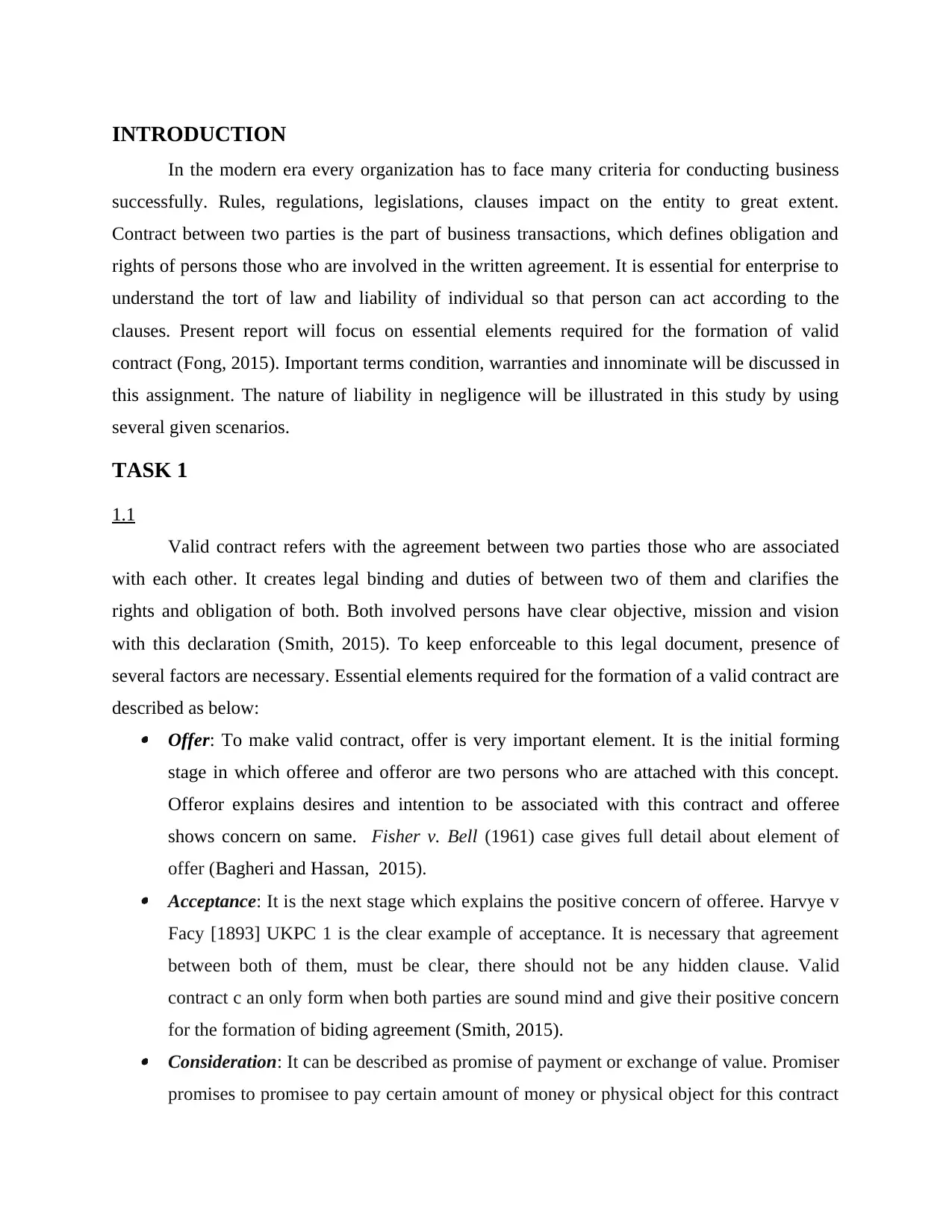
INTRODUCTION
In the modern era every organization has to face many criteria for conducting business
successfully. Rules, regulations, legislations, clauses impact on the entity to great extent.
Contract between two parties is the part of business transactions, which defines obligation and
rights of persons those who are involved in the written agreement. It is essential for enterprise to
understand the tort of law and liability of individual so that person can act according to the
clauses. Present report will focus on essential elements required for the formation of valid
contract (Fong, 2015). Important terms condition, warranties and innominate will be discussed in
this assignment. The nature of liability in negligence will be illustrated in this study by using
several given scenarios.
TASK 1
1.1
Valid contract refers with the agreement between two parties those who are associated
with each other. It creates legal binding and duties of between two of them and clarifies the
rights and obligation of both. Both involved persons have clear objective, mission and vision
with this declaration (Smith, 2015). To keep enforceable to this legal document, presence of
several factors are necessary. Essential elements required for the formation of a valid contract are
described as below: Offer: To make valid contract, offer is very important element. It is the initial forming
stage in which offeree and offeror are two persons who are attached with this concept.
Offeror explains desires and intention to be associated with this contract and offeree
shows concern on same. Fisher v. Bell (1961) case gives full detail about element of
offer (Bagheri and Hassan, 2015). Acceptance: It is the next stage which explains the positive concern of offeree. Harvye v
Facy [1893] UKPC 1 is the clear example of acceptance. It is necessary that agreement
between both of them, must be clear, there should not be any hidden clause. Valid
contract c an only form when both parties are sound mind and give their positive concern
for the formation of biding agreement (Smith, 2015). Consideration: It can be described as promise of payment or exchange of value. Promiser
promises to promisee to pay certain amount of money or physical object for this contract
In the modern era every organization has to face many criteria for conducting business
successfully. Rules, regulations, legislations, clauses impact on the entity to great extent.
Contract between two parties is the part of business transactions, which defines obligation and
rights of persons those who are involved in the written agreement. It is essential for enterprise to
understand the tort of law and liability of individual so that person can act according to the
clauses. Present report will focus on essential elements required for the formation of valid
contract (Fong, 2015). Important terms condition, warranties and innominate will be discussed in
this assignment. The nature of liability in negligence will be illustrated in this study by using
several given scenarios.
TASK 1
1.1
Valid contract refers with the agreement between two parties those who are associated
with each other. It creates legal binding and duties of between two of them and clarifies the
rights and obligation of both. Both involved persons have clear objective, mission and vision
with this declaration (Smith, 2015). To keep enforceable to this legal document, presence of
several factors are necessary. Essential elements required for the formation of a valid contract are
described as below: Offer: To make valid contract, offer is very important element. It is the initial forming
stage in which offeree and offeror are two persons who are attached with this concept.
Offeror explains desires and intention to be associated with this contract and offeree
shows concern on same. Fisher v. Bell (1961) case gives full detail about element of
offer (Bagheri and Hassan, 2015). Acceptance: It is the next stage which explains the positive concern of offeree. Harvye v
Facy [1893] UKPC 1 is the clear example of acceptance. It is necessary that agreement
between both of them, must be clear, there should not be any hidden clause. Valid
contract c an only form when both parties are sound mind and give their positive concern
for the formation of biding agreement (Smith, 2015). Consideration: It can be described as promise of payment or exchange of value. Promiser
promises to promisee to pay certain amount of money or physical object for this contract
⊘ This is a preview!⊘
Do you want full access?
Subscribe today to unlock all pages.

Trusted by 1+ million students worldwide
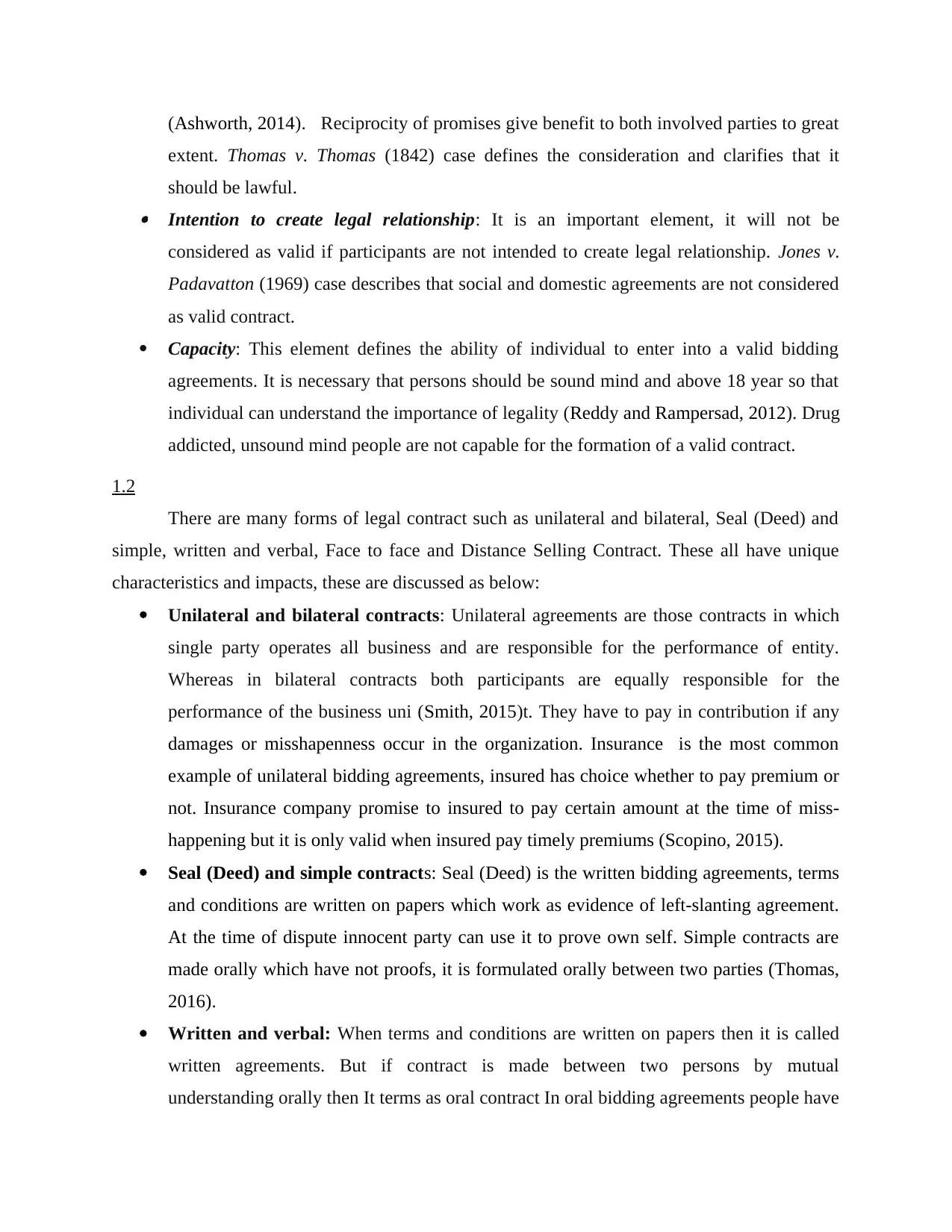
(Ashworth, 2014). Reciprocity of promises give benefit to both involved parties to great
extent. Thomas v. Thomas (1842) case defines the consideration and clarifies that it
should be lawful. Intention to create legal relationship: It is an important element, it will not be
considered as valid if participants are not intended to create legal relationship. Jones v.
Padavatton (1969) case describes that social and domestic agreements are not considered
as valid contract.
Capacity: This element defines the ability of individual to enter into a valid bidding
agreements. It is necessary that persons should be sound mind and above 18 year so that
individual can understand the importance of legality (Reddy and Rampersad, 2012). Drug
addicted, unsound mind people are not capable for the formation of a valid contract.
1.2
There are many forms of legal contract such as unilateral and bilateral, Seal (Deed) and
simple, written and verbal, Face to face and Distance Selling Contract. These all have unique
characteristics and impacts, these are discussed as below:
Unilateral and bilateral contracts: Unilateral agreements are those contracts in which
single party operates all business and are responsible for the performance of entity.
Whereas in bilateral contracts both participants are equally responsible for the
performance of the business uni (Smith, 2015)t. They have to pay in contribution if any
damages or misshapenness occur in the organization. Insurance is the most common
example of unilateral bidding agreements, insured has choice whether to pay premium or
not. Insurance company promise to insured to pay certain amount at the time of miss-
happening but it is only valid when insured pay timely premiums (Scopino, 2015).
Seal (Deed) and simple contracts: Seal (Deed) is the written bidding agreements, terms
and conditions are written on papers which work as evidence of left-slanting agreement.
At the time of dispute innocent party can use it to prove own self. Simple contracts are
made orally which have not proofs, it is formulated orally between two parties (Thomas,
2016).
Written and verbal: When terms and conditions are written on papers then it is called
written agreements. But if contract is made between two persons by mutual
understanding orally then It terms as oral contract In oral bidding agreements people have
extent. Thomas v. Thomas (1842) case defines the consideration and clarifies that it
should be lawful. Intention to create legal relationship: It is an important element, it will not be
considered as valid if participants are not intended to create legal relationship. Jones v.
Padavatton (1969) case describes that social and domestic agreements are not considered
as valid contract.
Capacity: This element defines the ability of individual to enter into a valid bidding
agreements. It is necessary that persons should be sound mind and above 18 year so that
individual can understand the importance of legality (Reddy and Rampersad, 2012). Drug
addicted, unsound mind people are not capable for the formation of a valid contract.
1.2
There are many forms of legal contract such as unilateral and bilateral, Seal (Deed) and
simple, written and verbal, Face to face and Distance Selling Contract. These all have unique
characteristics and impacts, these are discussed as below:
Unilateral and bilateral contracts: Unilateral agreements are those contracts in which
single party operates all business and are responsible for the performance of entity.
Whereas in bilateral contracts both participants are equally responsible for the
performance of the business uni (Smith, 2015)t. They have to pay in contribution if any
damages or misshapenness occur in the organization. Insurance is the most common
example of unilateral bidding agreements, insured has choice whether to pay premium or
not. Insurance company promise to insured to pay certain amount at the time of miss-
happening but it is only valid when insured pay timely premiums (Scopino, 2015).
Seal (Deed) and simple contracts: Seal (Deed) is the written bidding agreements, terms
and conditions are written on papers which work as evidence of left-slanting agreement.
At the time of dispute innocent party can use it to prove own self. Simple contracts are
made orally which have not proofs, it is formulated orally between two parties (Thomas,
2016).
Written and verbal: When terms and conditions are written on papers then it is called
written agreements. But if contract is made between two persons by mutual
understanding orally then It terms as oral contract In oral bidding agreements people have
Paraphrase This Document
Need a fresh take? Get an instant paraphrase of this document with our AI Paraphraser
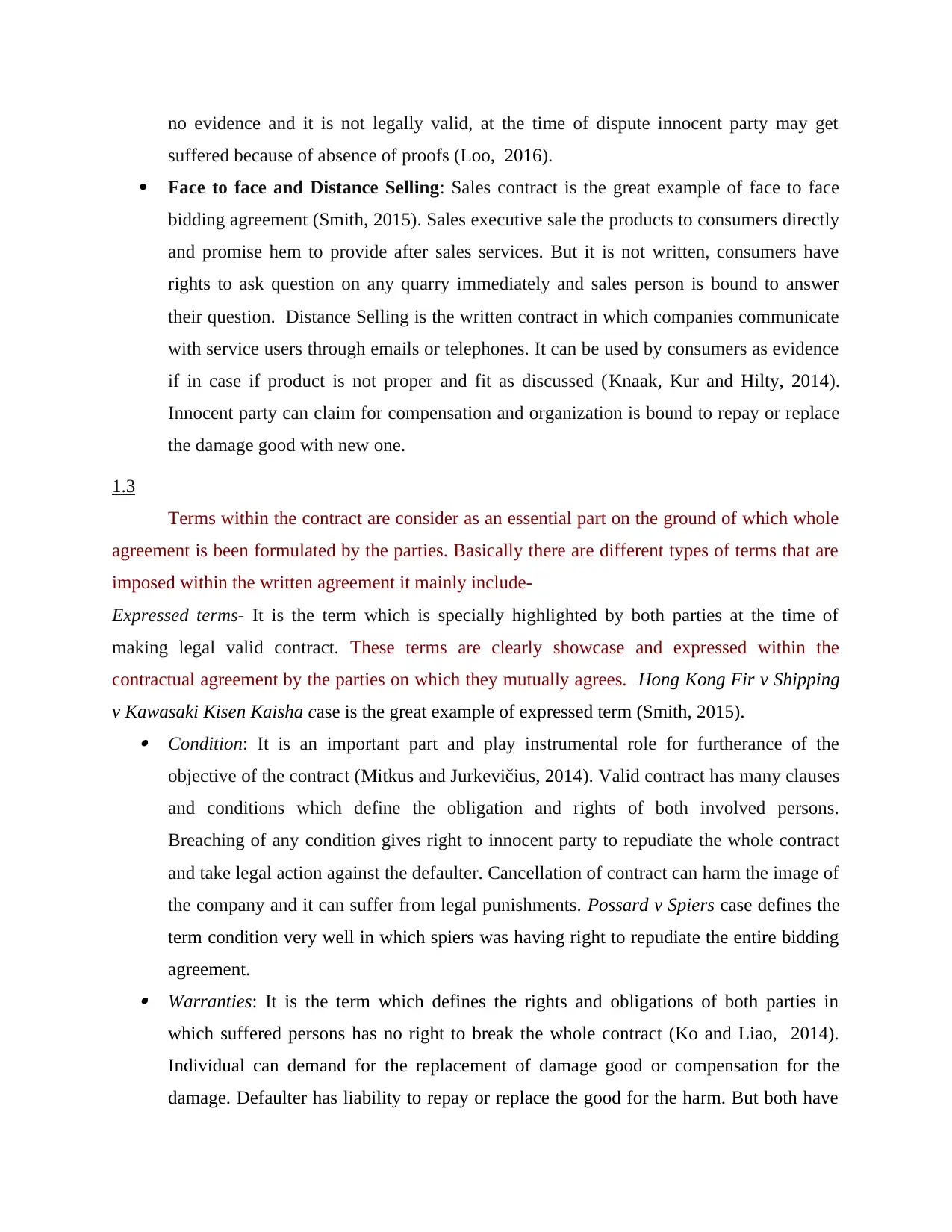
no evidence and it is not legally valid, at the time of dispute innocent party may get
suffered because of absence of proofs (Loo, 2016).
Face to face and Distance Selling: Sales contract is the great example of face to face
bidding agreement (Smith, 2015). Sales executive sale the products to consumers directly
and promise hem to provide after sales services. But it is not written, consumers have
rights to ask question on any quarry immediately and sales person is bound to answer
their question. Distance Selling is the written contract in which companies communicate
with service users through emails or telephones. It can be used by consumers as evidence
if in case if product is not proper and fit as discussed (Knaak, Kur and Hilty, 2014).
Innocent party can claim for compensation and organization is bound to repay or replace
the damage good with new one.
1.3
Terms within the contract are consider as an essential part on the ground of which whole
agreement is been formulated by the parties. Basically there are different types of terms that are
imposed within the written agreement it mainly include-
Expressed terms- It is the term which is specially highlighted by both parties at the time of
making legal valid contract. These terms are clearly showcase and expressed within the
contractual agreement by the parties on which they mutually agrees. Hong Kong Fir v Shipping
v Kawasaki Kisen Kaisha case is the great example of expressed term (Smith, 2015). Condition: It is an important part and play instrumental role for furtherance of the
objective of the contract (Mitkus and Jurkevičius, 2014). Valid contract has many clauses
and conditions which define the obligation and rights of both involved persons.
Breaching of any condition gives right to innocent party to repudiate the whole contract
and take legal action against the defaulter. Cancellation of contract can harm the image of
the company and it can suffer from legal punishments. Possard v Spiers case defines the
term condition very well in which spiers was having right to repudiate the entire bidding
agreement. Warranties: It is the term which defines the rights and obligations of both parties in
which suffered persons has no right to break the whole contract (Ko and Liao, 2014).
Individual can demand for the replacement of damage good or compensation for the
damage. Defaulter has liability to repay or replace the good for the harm. But both have
suffered because of absence of proofs (Loo, 2016).
Face to face and Distance Selling: Sales contract is the great example of face to face
bidding agreement (Smith, 2015). Sales executive sale the products to consumers directly
and promise hem to provide after sales services. But it is not written, consumers have
rights to ask question on any quarry immediately and sales person is bound to answer
their question. Distance Selling is the written contract in which companies communicate
with service users through emails or telephones. It can be used by consumers as evidence
if in case if product is not proper and fit as discussed (Knaak, Kur and Hilty, 2014).
Innocent party can claim for compensation and organization is bound to repay or replace
the damage good with new one.
1.3
Terms within the contract are consider as an essential part on the ground of which whole
agreement is been formulated by the parties. Basically there are different types of terms that are
imposed within the written agreement it mainly include-
Expressed terms- It is the term which is specially highlighted by both parties at the time of
making legal valid contract. These terms are clearly showcase and expressed within the
contractual agreement by the parties on which they mutually agrees. Hong Kong Fir v Shipping
v Kawasaki Kisen Kaisha case is the great example of expressed term (Smith, 2015). Condition: It is an important part and play instrumental role for furtherance of the
objective of the contract (Mitkus and Jurkevičius, 2014). Valid contract has many clauses
and conditions which define the obligation and rights of both involved persons.
Breaching of any condition gives right to innocent party to repudiate the whole contract
and take legal action against the defaulter. Cancellation of contract can harm the image of
the company and it can suffer from legal punishments. Possard v Spiers case defines the
term condition very well in which spiers was having right to repudiate the entire bidding
agreement. Warranties: It is the term which defines the rights and obligations of both parties in
which suffered persons has no right to break the whole contract (Ko and Liao, 2014).
Individual can demand for the replacement of damage good or compensation for the
damage. Defaulter has liability to repay or replace the good for the harm. But both have
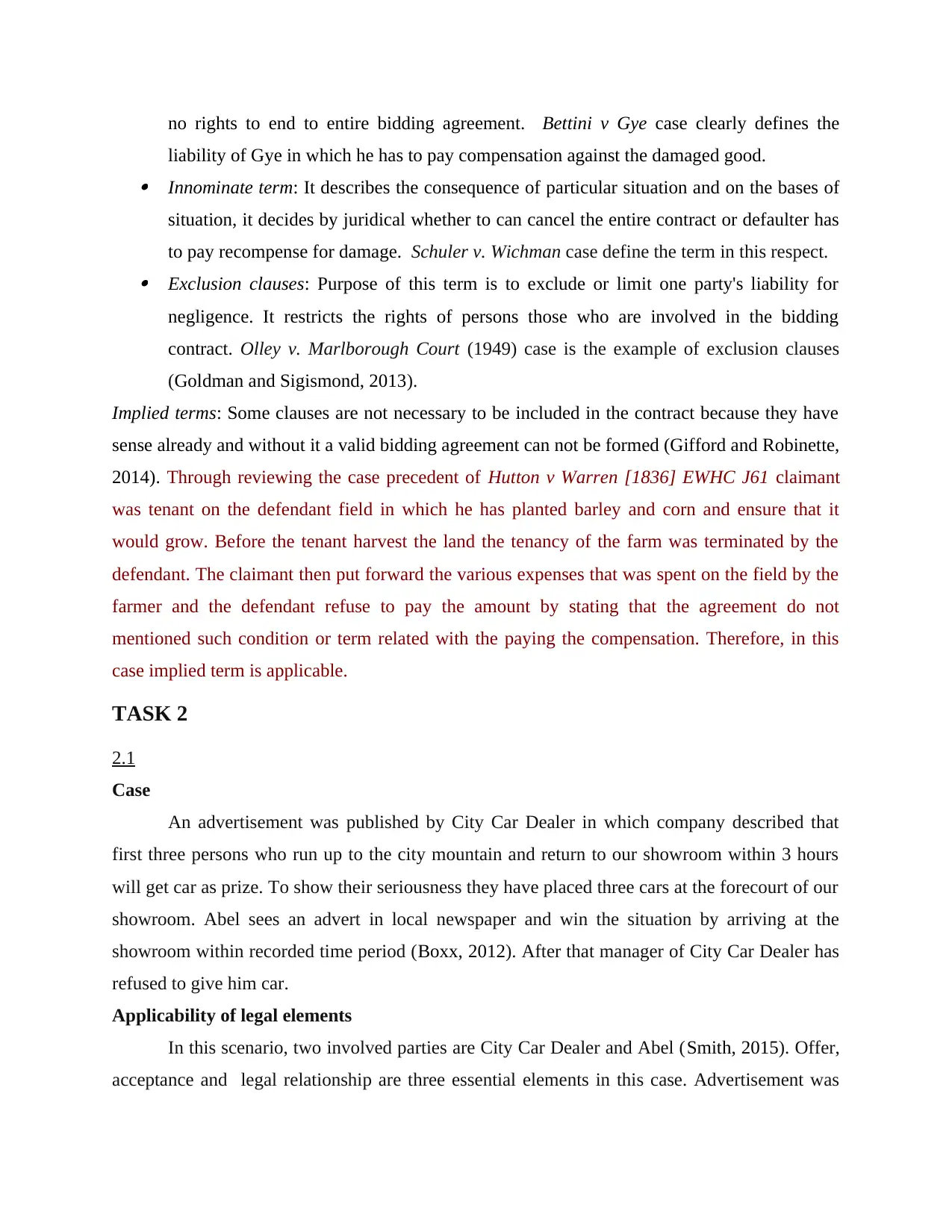
no rights to end to entire bidding agreement. Bettini v Gye case clearly defines the
liability of Gye in which he has to pay compensation against the damaged good. Innominate term: It describes the consequence of particular situation and on the bases of
situation, it decides by juridical whether to can cancel the entire contract or defaulter has
to pay recompense for damage. Schuler v. Wichman case define the term in this respect. Exclusion clauses: Purpose of this term is to exclude or limit one party's liability for
negligence. It restricts the rights of persons those who are involved in the bidding
contract. Olley v. Marlborough Court (1949) case is the example of exclusion clauses
(Goldman and Sigismond, 2013).
Implied terms: Some clauses are not necessary to be included in the contract because they have
sense already and without it a valid bidding agreement can not be formed (Gifford and Robinette,
2014). Through reviewing the case precedent of Hutton v Warren [1836] EWHC J61 claimant
was tenant on the defendant field in which he has planted barley and corn and ensure that it
would grow. Before the tenant harvest the land the tenancy of the farm was terminated by the
defendant. The claimant then put forward the various expenses that was spent on the field by the
farmer and the defendant refuse to pay the amount by stating that the agreement do not
mentioned such condition or term related with the paying the compensation. Therefore, in this
case implied term is applicable.
TASK 2
2.1
Case
An advertisement was published by City Car Dealer in which company described that
first three persons who run up to the city mountain and return to our showroom within 3 hours
will get car as prize. To show their seriousness they have placed three cars at the forecourt of our
showroom. Abel sees an advert in local newspaper and win the situation by arriving at the
showroom within recorded time period (Boxx, 2012). After that manager of City Car Dealer has
refused to give him car.
Applicability of legal elements
In this scenario, two involved parties are City Car Dealer and Abel (Smith, 2015). Offer,
acceptance and legal relationship are three essential elements in this case. Advertisement was
liability of Gye in which he has to pay compensation against the damaged good. Innominate term: It describes the consequence of particular situation and on the bases of
situation, it decides by juridical whether to can cancel the entire contract or defaulter has
to pay recompense for damage. Schuler v. Wichman case define the term in this respect. Exclusion clauses: Purpose of this term is to exclude or limit one party's liability for
negligence. It restricts the rights of persons those who are involved in the bidding
contract. Olley v. Marlborough Court (1949) case is the example of exclusion clauses
(Goldman and Sigismond, 2013).
Implied terms: Some clauses are not necessary to be included in the contract because they have
sense already and without it a valid bidding agreement can not be formed (Gifford and Robinette,
2014). Through reviewing the case precedent of Hutton v Warren [1836] EWHC J61 claimant
was tenant on the defendant field in which he has planted barley and corn and ensure that it
would grow. Before the tenant harvest the land the tenancy of the farm was terminated by the
defendant. The claimant then put forward the various expenses that was spent on the field by the
farmer and the defendant refuse to pay the amount by stating that the agreement do not
mentioned such condition or term related with the paying the compensation. Therefore, in this
case implied term is applicable.
TASK 2
2.1
Case
An advertisement was published by City Car Dealer in which company described that
first three persons who run up to the city mountain and return to our showroom within 3 hours
will get car as prize. To show their seriousness they have placed three cars at the forecourt of our
showroom. Abel sees an advert in local newspaper and win the situation by arriving at the
showroom within recorded time period (Boxx, 2012). After that manager of City Car Dealer has
refused to give him car.
Applicability of legal elements
In this scenario, two involved parties are City Car Dealer and Abel (Smith, 2015). Offer,
acceptance and legal relationship are three essential elements in this case. Advertisement was
⊘ This is a preview!⊘
Do you want full access?
Subscribe today to unlock all pages.

Trusted by 1+ million students worldwide
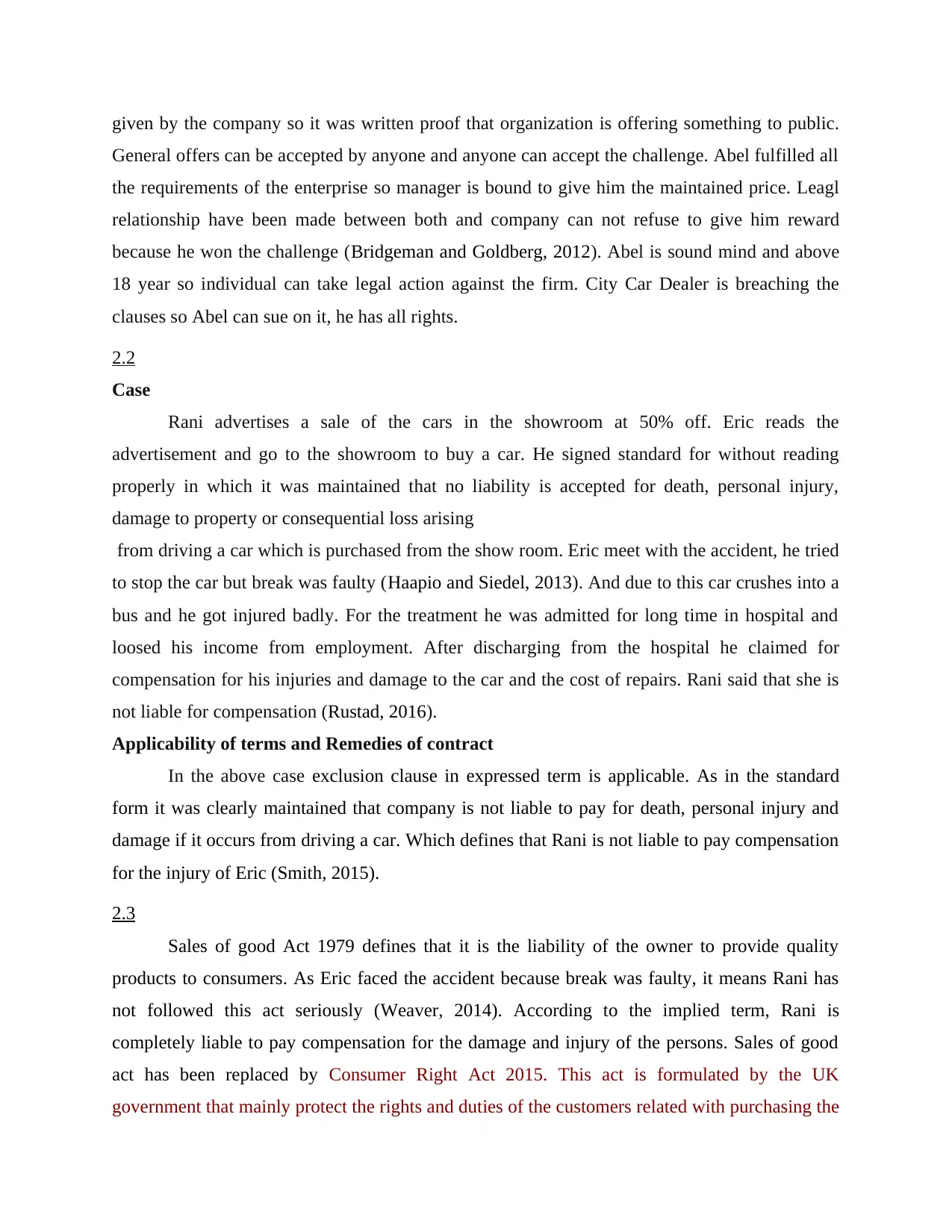
given by the company so it was written proof that organization is offering something to public.
General offers can be accepted by anyone and anyone can accept the challenge. Abel fulfilled all
the requirements of the enterprise so manager is bound to give him the maintained price. Leagl
relationship have been made between both and company can not refuse to give him reward
because he won the challenge (Bridgeman and Goldberg, 2012). Abel is sound mind and above
18 year so individual can take legal action against the firm. City Car Dealer is breaching the
clauses so Abel can sue on it, he has all rights.
2.2
Case
Rani advertises a sale of the cars in the showroom at 50% off. Eric reads the
advertisement and go to the showroom to buy a car. He signed standard for without reading
properly in which it was maintained that no liability is accepted for death, personal injury,
damage to property or consequential loss arising
from driving a car which is purchased from the show room. Eric meet with the accident, he tried
to stop the car but break was faulty (Haapio and Siedel, 2013). And due to this car crushes into a
bus and he got injured badly. For the treatment he was admitted for long time in hospital and
loosed his income from employment. After discharging from the hospital he claimed for
compensation for his injuries and damage to the car and the cost of repairs. Rani said that she is
not liable for compensation (Rustad, 2016).
Applicability of terms and Remedies of contract
In the above case exclusion clause in expressed term is applicable. As in the standard
form it was clearly maintained that company is not liable to pay for death, personal injury and
damage if it occurs from driving a car. Which defines that Rani is not liable to pay compensation
for the injury of Eric (Smith, 2015).
2.3
Sales of good Act 1979 defines that it is the liability of the owner to provide quality
products to consumers. As Eric faced the accident because break was faulty, it means Rani has
not followed this act seriously (Weaver, 2014). According to the implied term, Rani is
completely liable to pay compensation for the damage and injury of the persons. Sales of good
act has been replaced by Consumer Right Act 2015. This act is formulated by the UK
government that mainly protect the rights and duties of the customers related with purchasing the
General offers can be accepted by anyone and anyone can accept the challenge. Abel fulfilled all
the requirements of the enterprise so manager is bound to give him the maintained price. Leagl
relationship have been made between both and company can not refuse to give him reward
because he won the challenge (Bridgeman and Goldberg, 2012). Abel is sound mind and above
18 year so individual can take legal action against the firm. City Car Dealer is breaching the
clauses so Abel can sue on it, he has all rights.
2.2
Case
Rani advertises a sale of the cars in the showroom at 50% off. Eric reads the
advertisement and go to the showroom to buy a car. He signed standard for without reading
properly in which it was maintained that no liability is accepted for death, personal injury,
damage to property or consequential loss arising
from driving a car which is purchased from the show room. Eric meet with the accident, he tried
to stop the car but break was faulty (Haapio and Siedel, 2013). And due to this car crushes into a
bus and he got injured badly. For the treatment he was admitted for long time in hospital and
loosed his income from employment. After discharging from the hospital he claimed for
compensation for his injuries and damage to the car and the cost of repairs. Rani said that she is
not liable for compensation (Rustad, 2016).
Applicability of terms and Remedies of contract
In the above case exclusion clause in expressed term is applicable. As in the standard
form it was clearly maintained that company is not liable to pay for death, personal injury and
damage if it occurs from driving a car. Which defines that Rani is not liable to pay compensation
for the injury of Eric (Smith, 2015).
2.3
Sales of good Act 1979 defines that it is the liability of the owner to provide quality
products to consumers. As Eric faced the accident because break was faulty, it means Rani has
not followed this act seriously (Weaver, 2014). According to the implied term, Rani is
completely liable to pay compensation for the damage and injury of the persons. Sales of good
act has been replaced by Consumer Right Act 2015. This act is formulated by the UK
government that mainly protect the rights and duties of the customers related with purchasing the
Paraphrase This Document
Need a fresh take? Get an instant paraphrase of this document with our AI Paraphraser
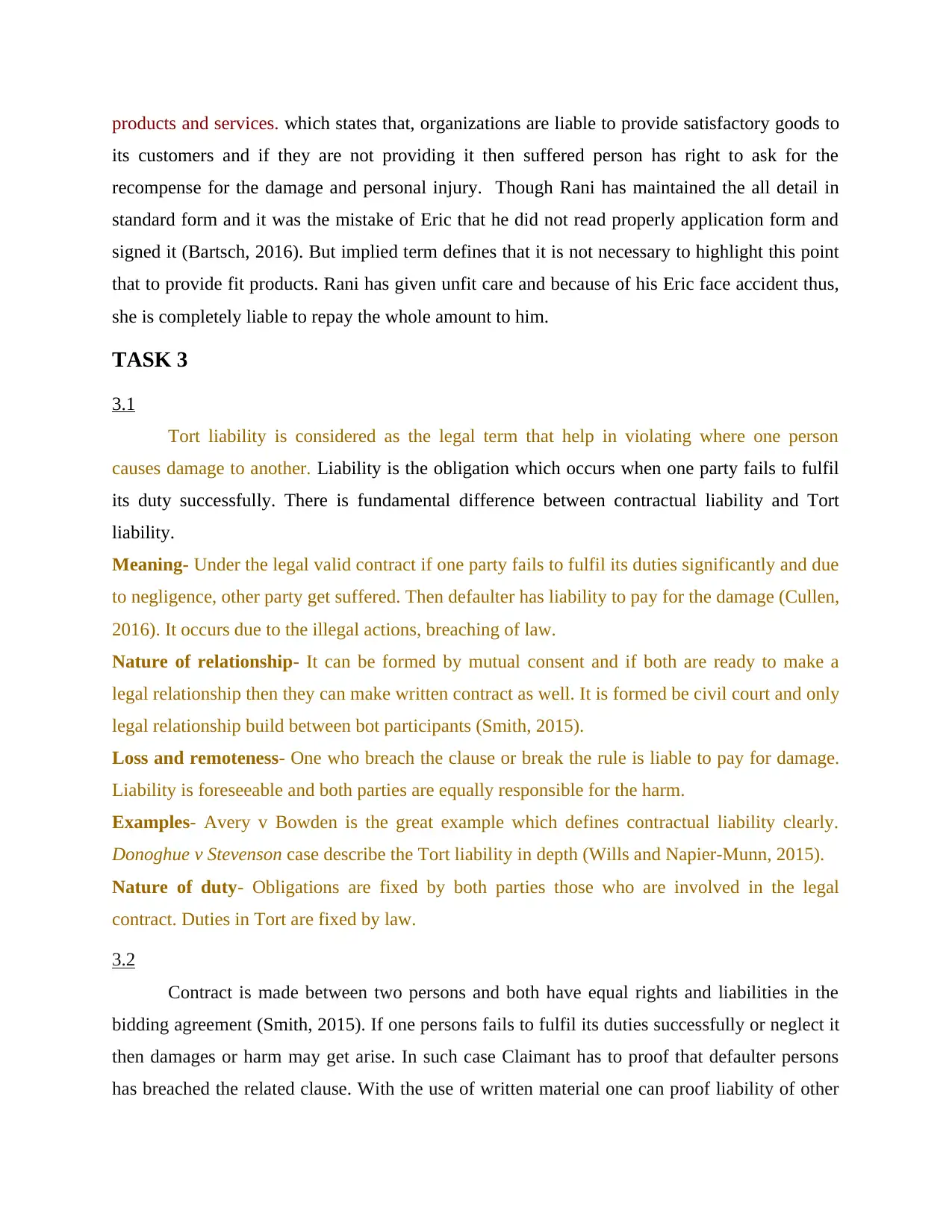
products and services. which states that, organizations are liable to provide satisfactory goods to
its customers and if they are not providing it then suffered person has right to ask for the
recompense for the damage and personal injury. Though Rani has maintained the all detail in
standard form and it was the mistake of Eric that he did not read properly application form and
signed it (Bartsch, 2016). But implied term defines that it is not necessary to highlight this point
that to provide fit products. Rani has given unfit care and because of his Eric face accident thus,
she is completely liable to repay the whole amount to him.
TASK 3
3.1
Tort liability is considered as the legal term that help in violating where one person
causes damage to another. Liability is the obligation which occurs when one party fails to fulfil
its duty successfully. There is fundamental difference between contractual liability and Tort
liability.
Meaning- Under the legal valid contract if one party fails to fulfil its duties significantly and due
to negligence, other party get suffered. Then defaulter has liability to pay for the damage (Cullen,
2016). It occurs due to the illegal actions, breaching of law.
Nature of relationship- It can be formed by mutual consent and if both are ready to make a
legal relationship then they can make written contract as well. It is formed be civil court and only
legal relationship build between bot participants (Smith, 2015).
Loss and remoteness- One who breach the clause or break the rule is liable to pay for damage.
Liability is foreseeable and both parties are equally responsible for the harm.
Examples- Avery v Bowden is the great example which defines contractual liability clearly.
Donoghue v Stevenson case describe the Tort liability in depth (Wills and Napier-Munn, 2015).
Nature of duty- Obligations are fixed by both parties those who are involved in the legal
contract. Duties in Tort are fixed by law.
3.2
Contract is made between two persons and both have equal rights and liabilities in the
bidding agreement (Smith, 2015). If one persons fails to fulfil its duties successfully or neglect it
then damages or harm may get arise. In such case Claimant has to proof that defaulter persons
has breached the related clause. With the use of written material one can proof liability of other
its customers and if they are not providing it then suffered person has right to ask for the
recompense for the damage and personal injury. Though Rani has maintained the all detail in
standard form and it was the mistake of Eric that he did not read properly application form and
signed it (Bartsch, 2016). But implied term defines that it is not necessary to highlight this point
that to provide fit products. Rani has given unfit care and because of his Eric face accident thus,
she is completely liable to repay the whole amount to him.
TASK 3
3.1
Tort liability is considered as the legal term that help in violating where one person
causes damage to another. Liability is the obligation which occurs when one party fails to fulfil
its duty successfully. There is fundamental difference between contractual liability and Tort
liability.
Meaning- Under the legal valid contract if one party fails to fulfil its duties significantly and due
to negligence, other party get suffered. Then defaulter has liability to pay for the damage (Cullen,
2016). It occurs due to the illegal actions, breaching of law.
Nature of relationship- It can be formed by mutual consent and if both are ready to make a
legal relationship then they can make written contract as well. It is formed be civil court and only
legal relationship build between bot participants (Smith, 2015).
Loss and remoteness- One who breach the clause or break the rule is liable to pay for damage.
Liability is foreseeable and both parties are equally responsible for the harm.
Examples- Avery v Bowden is the great example which defines contractual liability clearly.
Donoghue v Stevenson case describe the Tort liability in depth (Wills and Napier-Munn, 2015).
Nature of duty- Obligations are fixed by both parties those who are involved in the legal
contract. Duties in Tort are fixed by law.
3.2
Contract is made between two persons and both have equal rights and liabilities in the
bidding agreement (Smith, 2015). If one persons fails to fulfil its duties successfully or neglect it
then damages or harm may get arise. In such case Claimant has to proof that defaulter persons
has breached the related clause. With the use of written material one can proof liability of other
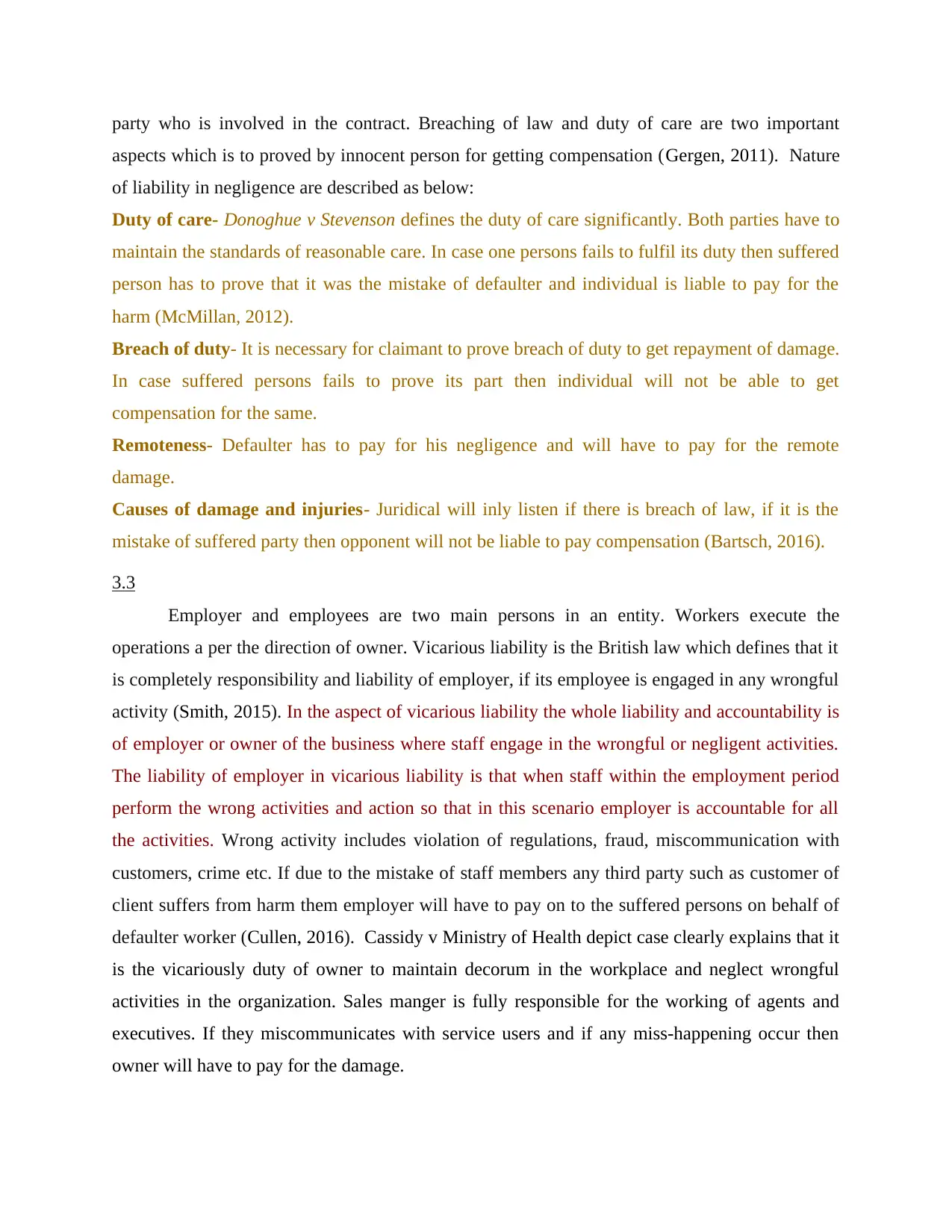
party who is involved in the contract. Breaching of law and duty of care are two important
aspects which is to proved by innocent person for getting compensation (Gergen, 2011). Nature
of liability in negligence are described as below:
Duty of care- Donoghue v Stevenson defines the duty of care significantly. Both parties have to
maintain the standards of reasonable care. In case one persons fails to fulfil its duty then suffered
person has to prove that it was the mistake of defaulter and individual is liable to pay for the
harm (McMillan, 2012).
Breach of duty- It is necessary for claimant to prove breach of duty to get repayment of damage.
In case suffered persons fails to prove its part then individual will not be able to get
compensation for the same.
Remoteness- Defaulter has to pay for his negligence and will have to pay for the remote
damage.
Causes of damage and injuries- Juridical will inly listen if there is breach of law, if it is the
mistake of suffered party then opponent will not be liable to pay compensation (Bartsch, 2016).
3.3
Employer and employees are two main persons in an entity. Workers execute the
operations a per the direction of owner. Vicarious liability is the British law which defines that it
is completely responsibility and liability of employer, if its employee is engaged in any wrongful
activity (Smith, 2015). In the aspect of vicarious liability the whole liability and accountability is
of employer or owner of the business where staff engage in the wrongful or negligent activities.
The liability of employer in vicarious liability is that when staff within the employment period
perform the wrong activities and action so that in this scenario employer is accountable for all
the activities. Wrong activity includes violation of regulations, fraud, miscommunication with
customers, crime etc. If due to the mistake of staff members any third party such as customer of
client suffers from harm them employer will have to pay on to the suffered persons on behalf of
defaulter worker (Cullen, 2016). Cassidy v Ministry of Health depict case clearly explains that it
is the vicariously duty of owner to maintain decorum in the workplace and neglect wrongful
activities in the organization. Sales manger is fully responsible for the working of agents and
executives. If they miscommunicates with service users and if any miss-happening occur then
owner will have to pay for the damage.
aspects which is to proved by innocent person for getting compensation (Gergen, 2011). Nature
of liability in negligence are described as below:
Duty of care- Donoghue v Stevenson defines the duty of care significantly. Both parties have to
maintain the standards of reasonable care. In case one persons fails to fulfil its duty then suffered
person has to prove that it was the mistake of defaulter and individual is liable to pay for the
harm (McMillan, 2012).
Breach of duty- It is necessary for claimant to prove breach of duty to get repayment of damage.
In case suffered persons fails to prove its part then individual will not be able to get
compensation for the same.
Remoteness- Defaulter has to pay for his negligence and will have to pay for the remote
damage.
Causes of damage and injuries- Juridical will inly listen if there is breach of law, if it is the
mistake of suffered party then opponent will not be liable to pay compensation (Bartsch, 2016).
3.3
Employer and employees are two main persons in an entity. Workers execute the
operations a per the direction of owner. Vicarious liability is the British law which defines that it
is completely responsibility and liability of employer, if its employee is engaged in any wrongful
activity (Smith, 2015). In the aspect of vicarious liability the whole liability and accountability is
of employer or owner of the business where staff engage in the wrongful or negligent activities.
The liability of employer in vicarious liability is that when staff within the employment period
perform the wrong activities and action so that in this scenario employer is accountable for all
the activities. Wrong activity includes violation of regulations, fraud, miscommunication with
customers, crime etc. If due to the mistake of staff members any third party such as customer of
client suffers from harm them employer will have to pay on to the suffered persons on behalf of
defaulter worker (Cullen, 2016). Cassidy v Ministry of Health depict case clearly explains that it
is the vicariously duty of owner to maintain decorum in the workplace and neglect wrongful
activities in the organization. Sales manger is fully responsible for the working of agents and
executives. If they miscommunicates with service users and if any miss-happening occur then
owner will have to pay for the damage.
⊘ This is a preview!⊘
Do you want full access?
Subscribe today to unlock all pages.

Trusted by 1+ million students worldwide
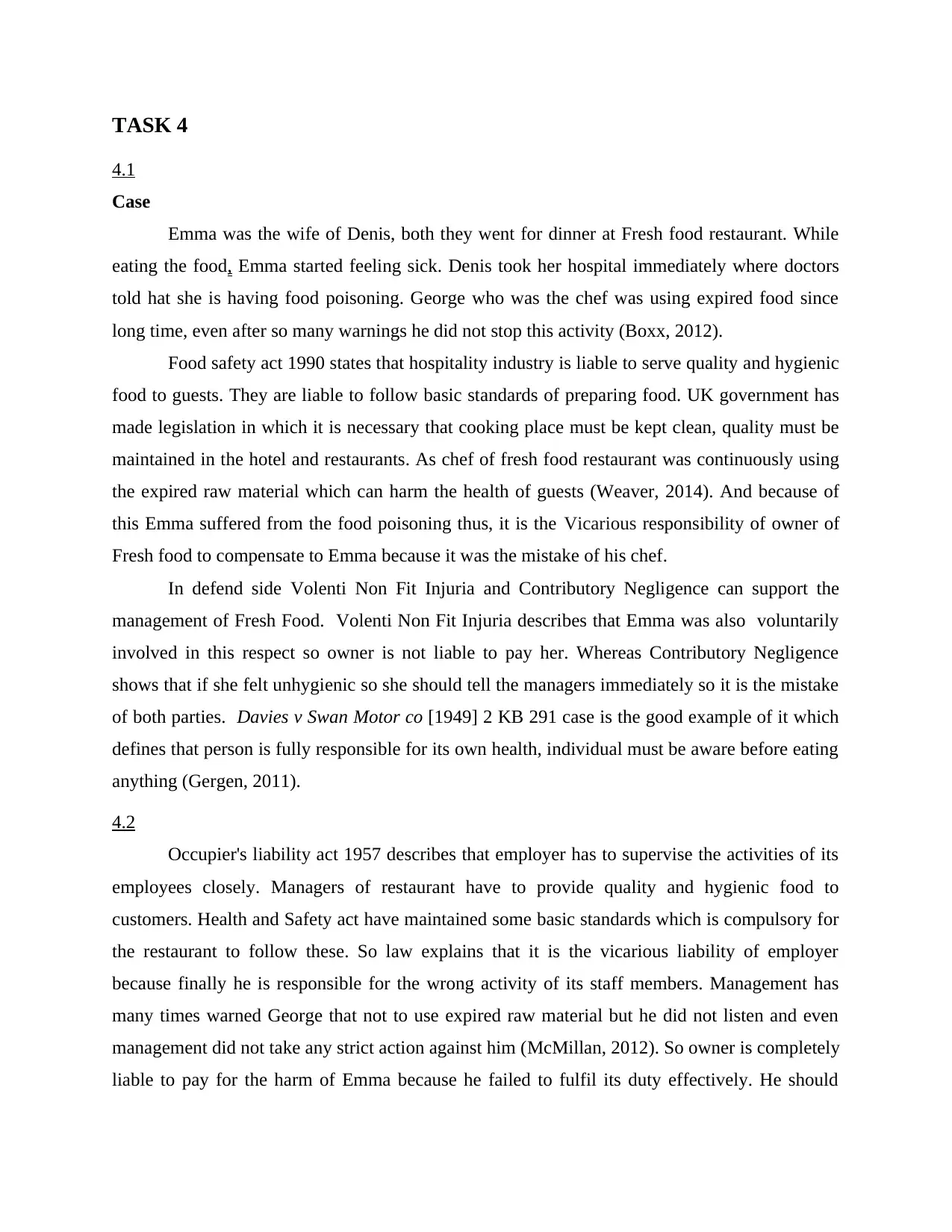
TASK 4
4.1
Case
Emma was the wife of Denis, both they went for dinner at Fresh food restaurant. While
eating the food, Emma started feeling sick. Denis took her hospital immediately where doctors
told hat she is having food poisoning. George who was the chef was using expired food since
long time, even after so many warnings he did not stop this activity (Boxx, 2012).
Food safety act 1990 states that hospitality industry is liable to serve quality and hygienic
food to guests. They are liable to follow basic standards of preparing food. UK government has
made legislation in which it is necessary that cooking place must be kept clean, quality must be
maintained in the hotel and restaurants. As chef of fresh food restaurant was continuously using
the expired raw material which can harm the health of guests (Weaver, 2014). And because of
this Emma suffered from the food poisoning thus, it is the Vicarious responsibility of owner of
Fresh food to compensate to Emma because it was the mistake of his chef.
In defend side Volenti Non Fit Injuria and Contributory Negligence can support the
management of Fresh Food. Volenti Non Fit Injuria describes that Emma was also voluntarily
involved in this respect so owner is not liable to pay her. Whereas Contributory Negligence
shows that if she felt unhygienic so she should tell the managers immediately so it is the mistake
of both parties. Davies v Swan Motor co [1949] 2 KB 291 case is the good example of it which
defines that person is fully responsible for its own health, individual must be aware before eating
anything (Gergen, 2011).
4.2
Occupier's liability act 1957 describes that employer has to supervise the activities of its
employees closely. Managers of restaurant have to provide quality and hygienic food to
customers. Health and Safety act have maintained some basic standards which is compulsory for
the restaurant to follow these. So law explains that it is the vicarious liability of employer
because finally he is responsible for the wrong activity of its staff members. Management has
many times warned George that not to use expired raw material but he did not listen and even
management did not take any strict action against him (McMillan, 2012). So owner is completely
liable to pay for the harm of Emma because he failed to fulfil its duty effectively. He should
4.1
Case
Emma was the wife of Denis, both they went for dinner at Fresh food restaurant. While
eating the food, Emma started feeling sick. Denis took her hospital immediately where doctors
told hat she is having food poisoning. George who was the chef was using expired food since
long time, even after so many warnings he did not stop this activity (Boxx, 2012).
Food safety act 1990 states that hospitality industry is liable to serve quality and hygienic
food to guests. They are liable to follow basic standards of preparing food. UK government has
made legislation in which it is necessary that cooking place must be kept clean, quality must be
maintained in the hotel and restaurants. As chef of fresh food restaurant was continuously using
the expired raw material which can harm the health of guests (Weaver, 2014). And because of
this Emma suffered from the food poisoning thus, it is the Vicarious responsibility of owner of
Fresh food to compensate to Emma because it was the mistake of his chef.
In defend side Volenti Non Fit Injuria and Contributory Negligence can support the
management of Fresh Food. Volenti Non Fit Injuria describes that Emma was also voluntarily
involved in this respect so owner is not liable to pay her. Whereas Contributory Negligence
shows that if she felt unhygienic so she should tell the managers immediately so it is the mistake
of both parties. Davies v Swan Motor co [1949] 2 KB 291 case is the good example of it which
defines that person is fully responsible for its own health, individual must be aware before eating
anything (Gergen, 2011).
4.2
Occupier's liability act 1957 describes that employer has to supervise the activities of its
employees closely. Managers of restaurant have to provide quality and hygienic food to
customers. Health and Safety act have maintained some basic standards which is compulsory for
the restaurant to follow these. So law explains that it is the vicarious liability of employer
because finally he is responsible for the wrong activity of its staff members. Management has
many times warned George that not to use expired raw material but he did not listen and even
management did not take any strict action against him (McMillan, 2012). So owner is completely
liable to pay for the harm of Emma because he failed to fulfil its duty effectively. He should
Paraphrase This Document
Need a fresh take? Get an instant paraphrase of this document with our AI Paraphraser
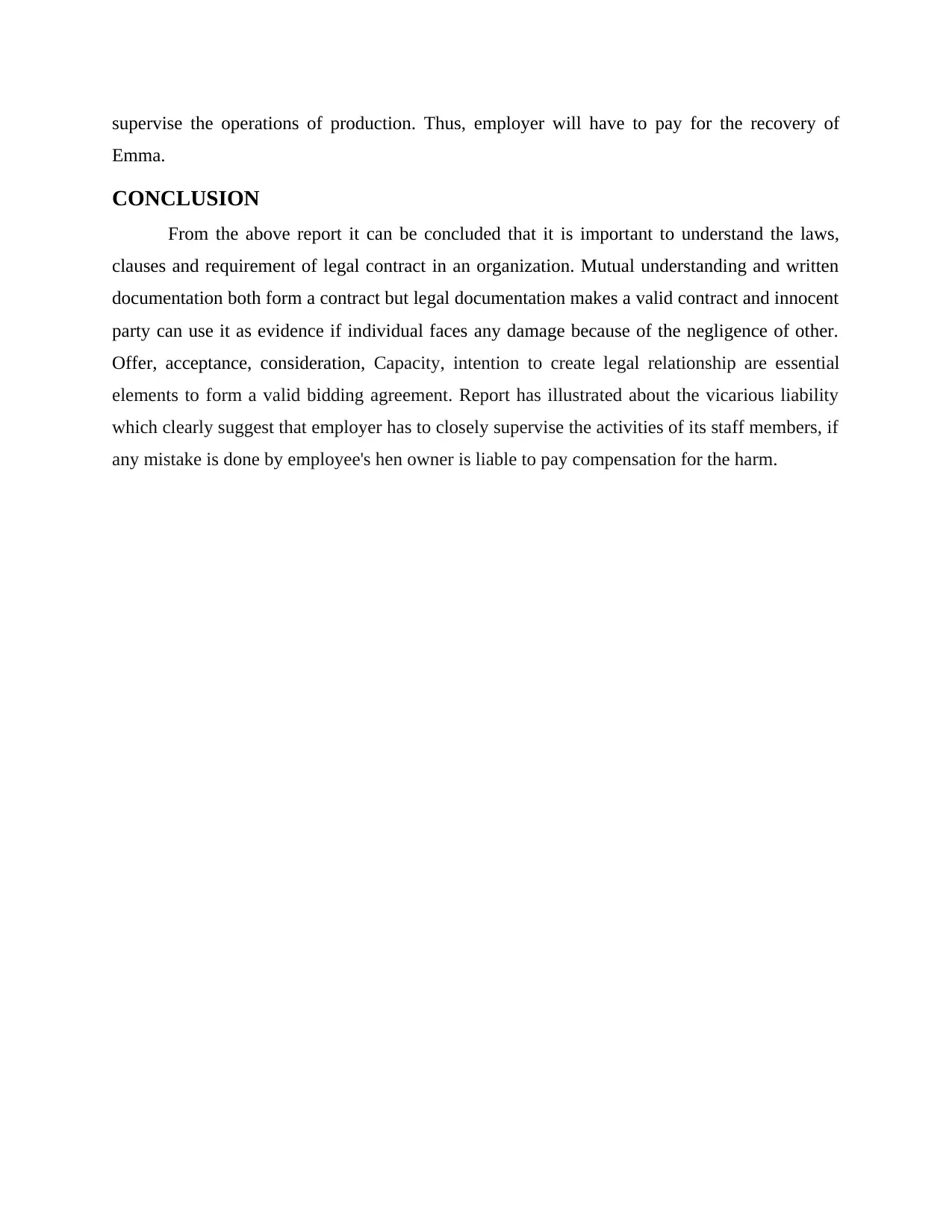
supervise the operations of production. Thus, employer will have to pay for the recovery of
Emma.
CONCLUSION
From the above report it can be concluded that it is important to understand the laws,
clauses and requirement of legal contract in an organization. Mutual understanding and written
documentation both form a contract but legal documentation makes a valid contract and innocent
party can use it as evidence if individual faces any damage because of the negligence of other.
Offer, acceptance, consideration, Capacity, intention to create legal relationship are essential
elements to form a valid bidding agreement. Report has illustrated about the vicarious liability
which clearly suggest that employer has to closely supervise the activities of its staff members, if
any mistake is done by employee's hen owner is liable to pay compensation for the harm.
Emma.
CONCLUSION
From the above report it can be concluded that it is important to understand the laws,
clauses and requirement of legal contract in an organization. Mutual understanding and written
documentation both form a contract but legal documentation makes a valid contract and innocent
party can use it as evidence if individual faces any damage because of the negligence of other.
Offer, acceptance, consideration, Capacity, intention to create legal relationship are essential
elements to form a valid bidding agreement. Report has illustrated about the vicarious liability
which clearly suggest that employer has to closely supervise the activities of its staff members, if
any mistake is done by employee's hen owner is liable to pay compensation for the harm.
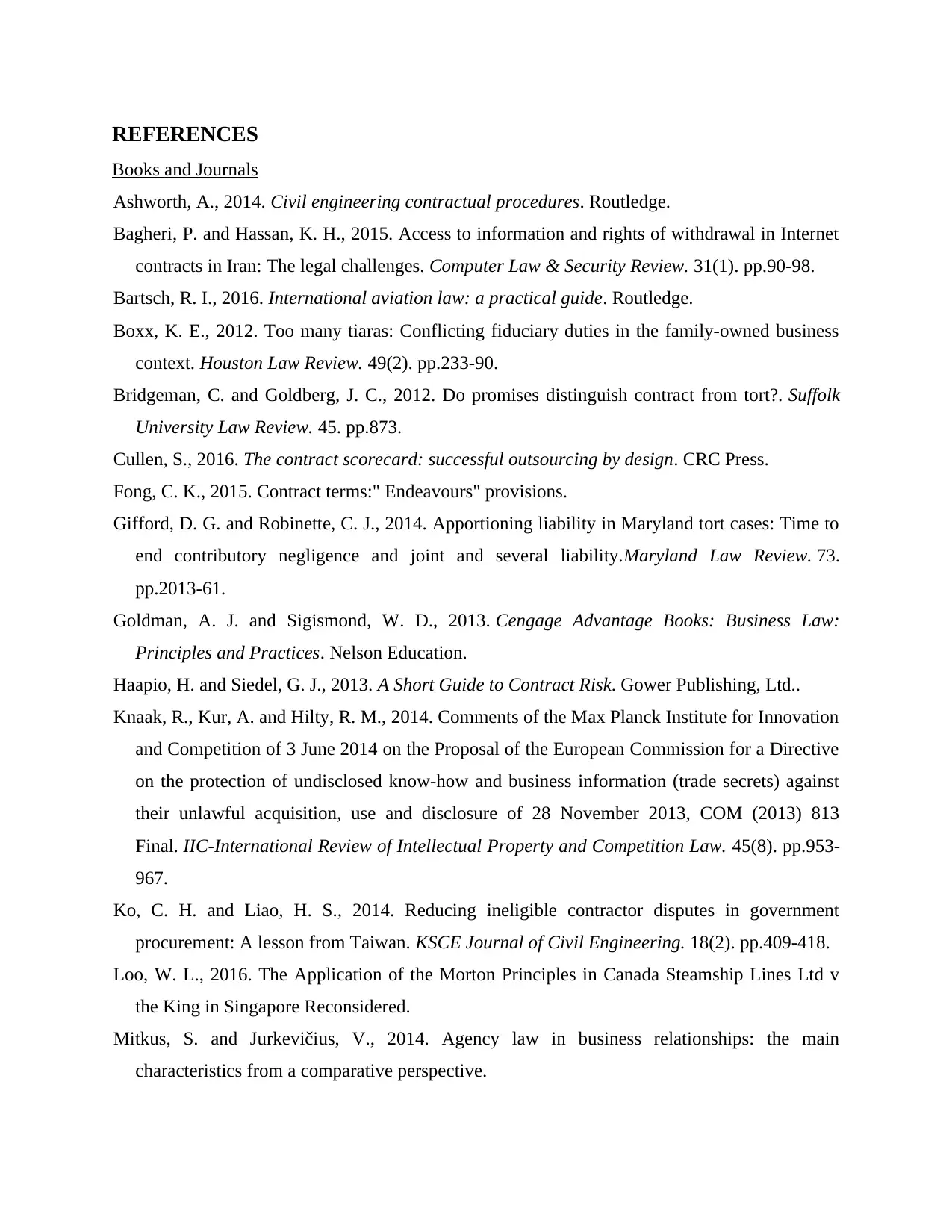
REFERENCES
Books and Journals
Ashworth, A., 2014. Civil engineering contractual procedures. Routledge.
Bagheri, P. and Hassan, K. H., 2015. Access to information and rights of withdrawal in Internet
contracts in Iran: The legal challenges. Computer Law & Security Review. 31(1). pp.90-98.
Bartsch, R. I., 2016. International aviation law: a practical guide. Routledge.
Boxx, K. E., 2012. Too many tiaras: Conflicting fiduciary duties in the family-owned business
context. Houston Law Review. 49(2). pp.233-90.
Bridgeman, C. and Goldberg, J. C., 2012. Do promises distinguish contract from tort?. Suffolk
University Law Review. 45. pp.873.
Cullen, S., 2016. The contract scorecard: successful outsourcing by design. CRC Press.
Fong, C. K., 2015. Contract terms:" Endeavours" provisions.
Gifford, D. G. and Robinette, C. J., 2014. Apportioning liability in Maryland tort cases: Time to
end contributory negligence and joint and several liability.Maryland Law Review. 73.
pp.2013-61.
Goldman, A. J. and Sigismond, W. D., 2013. Cengage Advantage Books: Business Law:
Principles and Practices. Nelson Education.
Haapio, H. and Siedel, G. J., 2013. A Short Guide to Contract Risk. Gower Publishing, Ltd..
Knaak, R., Kur, A. and Hilty, R. M., 2014. Comments of the Max Planck Institute for Innovation
and Competition of 3 June 2014 on the Proposal of the European Commission for a Directive
on the protection of undisclosed know-how and business information (trade secrets) against
their unlawful acquisition, use and disclosure of 28 November 2013, COM (2013) 813
Final. IIC-International Review of Intellectual Property and Competition Law. 45(8). pp.953-
967.
Ko, C. H. and Liao, H. S., 2014. Reducing ineligible contractor disputes in government
procurement: A lesson from Taiwan. KSCE Journal of Civil Engineering. 18(2). pp.409-418.
Loo, W. L., 2016. The Application of the Morton Principles in Canada Steamship Lines Ltd v
the King in Singapore Reconsidered.
Mitkus, S. and Jurkevičius, V., 2014. Agency law in business relationships: the main
characteristics from a comparative perspective.
Books and Journals
Ashworth, A., 2014. Civil engineering contractual procedures. Routledge.
Bagheri, P. and Hassan, K. H., 2015. Access to information and rights of withdrawal in Internet
contracts in Iran: The legal challenges. Computer Law & Security Review. 31(1). pp.90-98.
Bartsch, R. I., 2016. International aviation law: a practical guide. Routledge.
Boxx, K. E., 2012. Too many tiaras: Conflicting fiduciary duties in the family-owned business
context. Houston Law Review. 49(2). pp.233-90.
Bridgeman, C. and Goldberg, J. C., 2012. Do promises distinguish contract from tort?. Suffolk
University Law Review. 45. pp.873.
Cullen, S., 2016. The contract scorecard: successful outsourcing by design. CRC Press.
Fong, C. K., 2015. Contract terms:" Endeavours" provisions.
Gifford, D. G. and Robinette, C. J., 2014. Apportioning liability in Maryland tort cases: Time to
end contributory negligence and joint and several liability.Maryland Law Review. 73.
pp.2013-61.
Goldman, A. J. and Sigismond, W. D., 2013. Cengage Advantage Books: Business Law:
Principles and Practices. Nelson Education.
Haapio, H. and Siedel, G. J., 2013. A Short Guide to Contract Risk. Gower Publishing, Ltd..
Knaak, R., Kur, A. and Hilty, R. M., 2014. Comments of the Max Planck Institute for Innovation
and Competition of 3 June 2014 on the Proposal of the European Commission for a Directive
on the protection of undisclosed know-how and business information (trade secrets) against
their unlawful acquisition, use and disclosure of 28 November 2013, COM (2013) 813
Final. IIC-International Review of Intellectual Property and Competition Law. 45(8). pp.953-
967.
Ko, C. H. and Liao, H. S., 2014. Reducing ineligible contractor disputes in government
procurement: A lesson from Taiwan. KSCE Journal of Civil Engineering. 18(2). pp.409-418.
Loo, W. L., 2016. The Application of the Morton Principles in Canada Steamship Lines Ltd v
the King in Singapore Reconsidered.
Mitkus, S. and Jurkevičius, V., 2014. Agency law in business relationships: the main
characteristics from a comparative perspective.
⊘ This is a preview!⊘
Do you want full access?
Subscribe today to unlock all pages.

Trusted by 1+ million students worldwide
1 out of 13
Related Documents
Your All-in-One AI-Powered Toolkit for Academic Success.
+13062052269
info@desklib.com
Available 24*7 on WhatsApp / Email
![[object Object]](/_next/static/media/star-bottom.7253800d.svg)
Unlock your academic potential
Copyright © 2020–2025 A2Z Services. All Rights Reserved. Developed and managed by ZUCOL.





